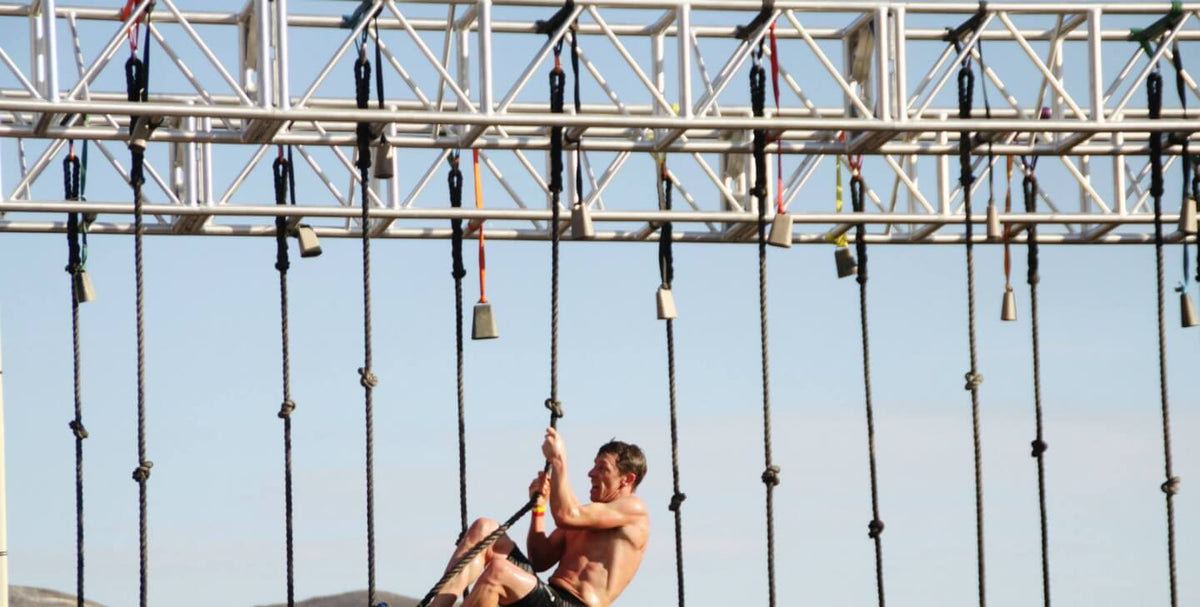7 Hardest Spartan Obstacles (+Insider Tips from Spartan Specialists to Conquer Them)

There are two ways to approach a Spartan obstacle: clueless or prepared. The latter means you’ve done your homework. It also means you’re far more likely to avoid the time-killing burpee penalty. And that’s where the Obstacle Specialist Class can help. In the class, 20 Spartans gather to master the sweaty art of throwing spears, climbing walls, and zipping across monkey bars with the dexterity of an actual monkey.
The classes started about a year ago in gyms, but they’ve since moved outdoors, to an actual course. And they’ve evolved to tackle the skills that Spartans find most frustrating. “We want each one of the participants to develop a skillset that is going to give them the best chance at clearing the obstacles consistently and under any conditions,” says Kevin Donoghue, a course instructor, Spartan Pro Team member, and two-time captain for the Spartan Ultimate Team Challenge.
So whether you’re taking on a Sprint or a Trifecta this year, use a few of these key takeaways from the Obstacle Specialist Class instructors to absolutely CRUSH Spartan race obstacles.
Olympus Wall
Challenge: Move laterally across an angled wall, using chains, holes, and grips to avoid touching the ground. Tip: Think about your squats.
You know the pose you hold when you’re roasting a marshmallow over an open fire? You’re too close for a chair, so you crouch down in not-quite-seated position. That’s what you need to remember as you move across the Olympus wall, says Donoghue. Keep your butt and hips as low as you can, and position your knees directly over your feet. “That allows you to be more perpendicular when you’re performing the obstacle,” he says. “And that’s going to take a lot of pressure off of your arms.”
And another thing: Don't alternate between using chains, holes, or grips. Stick to just one type of hand-hold so you can develop a rhythm that will carry you straight to the finishing bell.
Spear Throw
Challenge: Hit the bail of hay, and stick it so firmly that the spear doesn’t fall out. Tip: Imagine throwing a football.
There’s no substitute for target practice, but even if you haven’t spent hours throwing a spear, you can improve your odds of hitting the bail by focusing on your form. “Stand as strong and stable as you can, holding the spear next to your ear,” says Joe DiStefano, a.k.a. Joe D.I., Spartan’s director of training and sport who created the Obstacle Specialist Class curriculum. If you’re right-handed, start with your left shoulder pointed at the target—imagine a quarter back about to throw a football. Then pivot your body so that your spear-holding hand takes the lead. “Straighten your arm and point your finger at the target,“ says DiStefano.
Related: Top 4 Most Commonly Failed Spartan Obstacles (+ Pro Tips to Conquer Them)
Of course, you might find it hard to focus on form if your veins are pumping pure adrenaline. So before you throw, consider taking a few seconds to decompress with a breathing exercise. (If it sounds crazy to burn precious seconds on breathing, just consider the time you’ll save if you hit the target and avoid doing burpees.) “Block one nostril to inhale, and then block the other nostril to exhale,“ DiStefano says. “That can really calm the nervous system.“
Twister
Challenge: Carry yourself the length of a bar that’s spinning like a DNA-style helix. Tip: Alternate your grip.
This was a tip Donoghue actually picked up from a student who learned that when his hands faced toward each other, the Twister was easier to handle. “I had both my hands supinated the entire time,” says Donoghue. “And then I changed my hands to a combination of supination and pronation. Just that one little adjustment made the obstacle that much easier.”
Related: Surviving the Twister
It’s also a good idea to keep your knees and elbows bent to 90 degrees. That will help you swing your bodyweight more effectively and handle the sideways motion necessary to make it to the end.
Rope Climb
Challenge: Make it to the top fast, and then back to earth without injuring yourself. Tip: S-wrap up, J-hook down.
The S-wrap, wherein the rope falls along the side of your body and loops under your foot, transfers maximum climbing power into your legs, so you can save your arm strength. And the J-hook, the one where the rope falls between your legs, lets the rope slide more freely, while keeping your legs engaged just enough that you don’t burn your hands on the rope as you freefall down.
Technically the two strategies are interchangeable, but it’s most efficient to use S up, and J down.
Related: 5 Workouts for Rope Climb Success
Monkey Bars
Challenge: Travel from one end to the other without letting your feet touch the ground. Tip: Practice hanging out.
The skill itself is easy enough to figure out—odds are you first swang on monkey bars as a kid. But if your adult body is lacking in upper-body strength, then you’re going to find modern-day monkey bars excruciatingly hard to execute. So start by prepping in the gym, by hanging from a pullup bar, DiStefano says. “Once you can hang for 60 seconds, then you can do the monkey bars.“ (Not to mention the other upper-body obstacles.)
Related: How to Master the Monkey Bar Obstacle Like a Champ
Bucket Carry
Challenge: Climb the hills while carrying a loaded 5-gallon bucket. Tip: Hit the mountains.
When people struggle here, they tend to think it’s because they don't have enough arm strength. But the bucket carry requires far more aerobic fitness, DiStefano says. So get ready to sweat.
Related: 5 Workouts for the Bucket Carry
“To train for the bucket, do 10-minute intervals of hill running,” DiStefano says. “Then move on to 10-minute carries taking as few rests as possible.”
Not sure how to hold the bucket? Check this out:
Wall Climb
Challenge: Clearing the wall, and then coming down safely on the other side. Tip: Stay present.
You know what it takes to get up the wall, right? It takes upper-body strength—or the helping hand of a fellow racer. But coming down is where people tend to get into trouble. “No one gets hurting climbing a wall,” DiStefano says. Or climbing the rope or clearing the slip wall, for that matter. “It’s coming off of these things that people get hurt, so mastering dismounts is critical.”
Related: This Upper Body Strength Workout Will Help You Crush Obstacles
So two rules to follow: One, don’t celebrate too early—the obstacle isn’t complete until you’re safely on the ground. And two, if you have to jump from anything, land properly, keeping your hips square, your feet parallel to each other, and your knees bent slightly. Come down on the balls of your feet (not your heels!) and let your hips sink to absorb the shock of impact.




